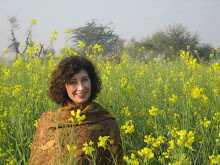
I put on my Ganesh necklace this morning in honor of the coming new year. Ganesh is the popular elephant headed god in the Hindu religion. In short, this jovial and big-bellied deity is the god of new beginnings, auspicious occasions, good fortune and the remover of obstacles.
Ganesh is the son of Shiva (the Destroyer) and his consort Parvati. Why does he have the head of an elephant? Because, Shiva was gone meditating in the mountains for a very long time and didn't know Parvati had bore him a son. When Shiva came home, a small boy was guarding the gate and would not let him enter to see Parvati. Shiva became enraged since it was his home and cut off the boy's head. It was Ganesh, Shiva's son. Parvati was understandably stricken when she saw what happened. She demanded Shiva remedy the situation. They prayed to Brahma, the creator. Brahma told Shiva to find the first living being and attach a new head to the boy. A baby elephant was the first thing Shiva ran into. Hence, the new elephant head.
While looking at jewelry in Jaipur I found the most beautiful carved coral Ganesh surrounded by an oval of polki (rose-cut) diamonds. I have never seen anything like it and knew it was meant for me. I didn't hesitate to buy it. A friend told me I should have it blessed before wearing it. Sounded like a good idea to me.
In Jaipur there is a very old Ganesh temple, Garh Ganesh. It's high atop a hill. My friend assured me we could drive up part of it. It was about 90 degrees that day in October. The tuk tuk driver let us off at the base of the stairs. It was still quite a climb. The stone steps were about 18 inches deep. We started the climb.
I saw families with little children walking up, the women in long saris and flip flops. Lone devotees ascended while young boys descended, practically running down the steep steps, sure-footed as mountain goats. Along the way we saw several little green bee-eaters flitting about and perched on skinny branches. They were so close, their little black eyes bright, and iridescent green feathers glinting in the sun. We stopped and watched them for a while.
It took about 30 minutes make the climb. On the way up I built a house. Actually, believers take rocks and make little "houses" out of them in the hopes that their dream home materializes. I built one, not because I want a house, but I liked doing it. At the top of the stairs we were rewarded with a panoramic view of Jaipur.
There were just a few people standing outside the temple selling items to offer Ganesh and use in worship: coconuts, incense, flower garlands. I looked at the silver doors to the temple. It was like looking at the emerald green doors to the Wizard of Oz. It was closed! I was crushed. But wait, it was 3:55pm. It opened at 4pm.

I rang the temple bell upon entering to clear my mind. The giant orange Ganesh was there, decorated with silver, flowers, and other colorful accoutrements. The priest sat before him. He didn't seem all that interested in the few devotees before him. He was much more involved in watching the 6-screen security system above. Sort of like being distracted by television when you're at a bar rather than engaging with your companion.
My friend asked the priest in Hindi to bless my Ganesh necklace. The priest said something in Hindi and put an orange tilak (vermillion paste) on my orange coral Ganesh. The mark was almost indistinguishable. Then he offered the vermillion to me and I used my middle finger to apply the tilak to my third eye. This was the first time this ritual was self-service. My friend explained to me that this was the sanctioned way of application for women. But, "If the priest wants to touch a lady then he will put it." Ah. I gave the priest 200 rupees for his time, blessing, and as an offering to Ganesh. The sun was low in the sky as we walked down the steep steps from the temple.
It's been a couple of months since then. My Ganesh still has traces of the tilak on his forehead. I'm looking forward to a new year full of new beginnings, joy, and successes. May 2009 bring peace, health and happiness to all beings. Om Shanti Om.










